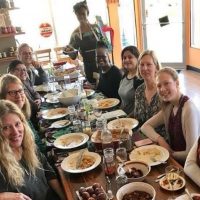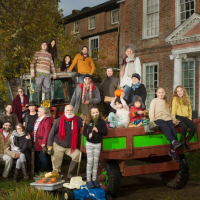history's most radical COMPLEX UNION experiment


Inarguably John Humphrey Noyes was America’s most revolutionary self-professed Christian Socialist to ever actually get down to the nuts and bolts of putting into practice his radical ideas on how ‘common purse’ communities should structure ‘common wealth’ production and distribution. As a non-ordained preacher, amongst other avant-garde societal reformist pursuits, Noyes set up an anti-slavery society in New Haven in the early 1830’s. This is where the visionary and humanitarian activist cut his teeth, so to speak.
From there, after considerable investigation and contemplation, Noyes decided that it was more than possible to establish the Kingdom of Heaven, on Earth, right here and now; no waiting. This conviction of course was in direct opposition to all that was commonly preached and promised by the Christian clergy at the time; as it is, right down to this present day. Clearly Noyes was unimpressed with the common clergy’s ‘lay away plan’ for heavenly rewards.
Investigating Alternative Social & Economic Models
Irrefutably, Noyes was genuinely deeply concerned for the common man, and thus he took to investigating the theories of Robert Owen, the committed Scottish industrialist who left Scotland to establish a model of a more equitable society in the United States. Noyes also undertook a thorough examination of the doctrines and moral principles of the French socialist, Charles Fourier, whose ideas were receiving wide acclaim across America and also further afield at the time. It seemed every corner of the globe was desperately searching for a new economic and social model that would put to an end the continual cycles of economic boom and bust.
As the worst of the 1837 economic depression hit turning thousands of jobless poor and destitute families out into the streets to the face the cold and hopelessness of hunger, homelessness, the worst of winters and the insecurity of an unknown future, Noyes’s search became serious. Suddenly he was desperate to find answers.
In that same year, Noyes earnestly researched the finer details and ideals of communal economic policies and principles that formed the basis of the Shakers and also Brook Farm that had just been setup outside of Boston. And there it was, all the pieces that had puzzled him and that he couldn’t get to fit together for so long, suddenly fell into place. It was as if the heavens opened and revealed their order. He couldn’t get passed it; Noyes was thoroughly convicted that socialism devoid of the higher principles of religious faith and practice, could not happen. It just didn’t have enough to glue it together.
Establishing Complex Union from a base of advanced Moral Principles & Practices
Through further research of past and present communities ‘holding all things in common’, Noyes could see it, taste it, and almost touch the reality of socialism founded on the religious aim of personal and social perfection, coming to fruition. Without doubt it was this ideal that was the missing link in the chain of essential components that saw so many previous attempts to found socialist organizations and projects, fail.
By understanding what didn’t work, Noyes believed he had a plan; and as an already recognized Christian preacher as well as a somewhat acclaimed publisher, he also had a noteworthy platform from which to launch it.
Noyes’s formal account of his investigations into socialist communities recorded in ‘History of American Socialisms’, bears witness to his conviction that his recipe for socialism was invincible. And it seemed he wasn’t too far wrong; because later his ideas grew significant roots amongst the majority of European countries when democracy began to show its fatal flaws by advancing and plunging whole countries and states into total economic dead-lock.
Thus, many in positions of power and profit, along with those without either, were eager, if not desperate to move beyond the fickle forces of continual flip-flops of democratic government that ultimately controlled supply and demand. Even back in the 1800’s, the structure and design of the piggy-back marriage between democracy and capitalism, proved a dismal failure, over and over, as it continues to, close to two centuries on.
At the time of Noyes’s communitarian common purse complex marriage experiment, the instability and chaos of unregulated markets and production were finally seen for what they were – the root cause of the continual economic collapse and subsequent ruin that gave rise to violent clashes and uprisings that cut across Europe and elsewhere – moving borders at the expense of thousands of lives and a mass of hard-won infrastructure.
Clearly social and economic organization had to give way to sanity. And it did. In due course, many Christian Socialists joined together to create political parties that subsequently rose to become leading instruments of continental political reform that effected significant production and distribution restructuring.
Communitarian Community Sharing All With ALL
Yet back on America soil, long before the Europeans were inspired or motivated to organize and demonstrate Christian socialism on their home turf, Noyes took to experimenting with its actual design in concrete form rather than standing in opposition contesting the issues. Continually, Noyes demonstrated he was a man of action, rather than a politician content to debate conjectured policies and parliamentary bills. In 1848, Noyes threw his all into establishing the Oneida Community as a communitarian community styled after the early Christians portrayed in the New Testament that reawakened the perfecting social principle and practice of ‘holding all things in common’.
Beyond Possession of Property & People
However Noyes’s perception of a perfectionist community did not only include the sharing of property and possessions. He went further, believing that the evils in society arose from selfishness and exclusive possession, not only of goods, but of persons. His understanding of ‘perfect love’ extended to the realization of God’s intentions and Jesus’s declaration recorded in Matthew 22:23-30, ‘Those who are resurrected, neither marry, nor are given in marriage’. Consequently, Noyes reasoned that in Heaven, it was only marriage that is abandoned. Nowhere in the recorded scriptures was it indicated that sex was done away with in Heaven – only marriage, and along with it the binding of one to another, exclusively.
Under this premise, Noyes took the insights regarding the abandonment of singular exclusive marriage even further. He quotes from scripture; ‘Man is a creature of his appetites.’ Accordingly, he concluded that there was no reason why sexual intercourse should be restrained by law; any more than a man or a woman’s other appetites are dictated and censored by church or state law.
Certainly, it was a radical notion. Nowhere in recorded history had sexual freedom, ever been proposed or sanctioned by Jew, Gentile or Muslim religious leaders. Nonetheless as part of Noyes’ Christian-socialist rally to pull a community together, he began preaching and installing this progressive doctrine as the social and extended relationship structure of the new Heaven on Earth. Under this decree, it followed that the first of the communal groups were founded on a constitution whereby there would be no exclusive marriage or relationships, and hence no jealousy, for all were bound under Christian love, to love all within the association, without attachment.
Unsurprisingly, Noyes’s twist on Christian Socialism that was completely divorced from conventional or historic social norms, saw the once in-demand, preacher and promotor of the socialist agenda, immediately denounced and defamed by those who had previously held the man in high esteem.
Condemnation Fuels the Perfectionist Fever
However despite the widespread public ridicule, Noyes wasn’t fazed. On the contrary, the scorn he received from his peers, seemed only to fuel the already raging desire to materialize his vision and literal interpretation of scripture. Through the courage and daring to continue preaching the moral and ethical foundations of ‘liberated love’ despite severe backlash, over a period of 30 years, more than three hundred men and women took to the ideal of complex marriage that included sexual relations with more than one partner.
Noyes soon presented a compelling case to his followers that the pleasures of sex were created by God, and therefore meant to be enjoyed by men and women equally. However, it is a grossly misguided track to believe that the Oneida Community’s sexual mores constituted ‘a free-for-all’, or one big orgy. The reality was far removed from the majority of outside conjectures. Obviously Noyes was smart enough to install certain codes of conduct underpinned by clearly stipulated rules and regulations to ensure that every male and female respected and treated everyone else, without exception, as their beloved spouse.
Male Continence
At the centre of these controls was the principle and practice of male sexual continence – essentially ‘coitus reservatus’ whereby the males of the group were taught to halt climax and thus ejaculation, to avoid impregnating any of the females. Did the model work? According to several inside and outside accounts that are still accessible, the majority of the members of the Christian Socialist Community, did live happily ever after under Noyes’s experimental design of social, sexual and religious organization and association.
Common Purse Provisioning
Alongside managing the complex social-side of the Oneida group, the 300 strong community also had to earn a living. Nothing was free or handed to the group. There were no government assistance, no food stamps or ration cards – no state issue welfare of any kind to prop the community up. Consequently, right from the start every member had to pull their weight, or else the ship would sink. Initially the group had to lease land, renovate buildings at their own expense, as well as, set up extensive food production systems.
Notably in the beginning, raising sufficient funds to conduct their affairs was a severe challenge. Initially, the community’s income was derived from logging and farming; however, these rural hard-labour and resource-input heavy activities did not produce enough income to cover the living expenses of the rapidly expanding community. Certainly, in those early days, it was a harrowing struggle to make ends meet.
However in 1855 the major burden was lifted when a new member arrived bringing with them considerable manufacturing expertise. As a result, the quick success of the industries set up under the management of this skilled member, soon convinced Noyes to pursue manufacturing rather than farming as a way to ensure the economic security and advancement of the community, he headed.
Evaluating Oneida's Common Purse Complex Union Model
A study of the Oneida complex marriage social and common purse experiment stimulates much discussion from a diverse range of closeted or otherwise dedicated and active societal reformers. Amongst communitarian study groups, the most common questions asked, centre around whether Noyes’s brand of complex union – modified, or otherwise left intact and followed to the letter, offers a workable frame and blueprint to construct and sustain satisfying and universally successful communal support associations within our current economic climate, social mores and common moral and ethical attitudes?
Whether Oneida’s income-sharing model and complex marriage model could be reformed to satisfy the social and economic needs of current generations, is, as yet unproven. Still, there are many who recognize the value of the 30-year social experiment, and are already engaged in extracting the lessons to evolve similar complex unions.









